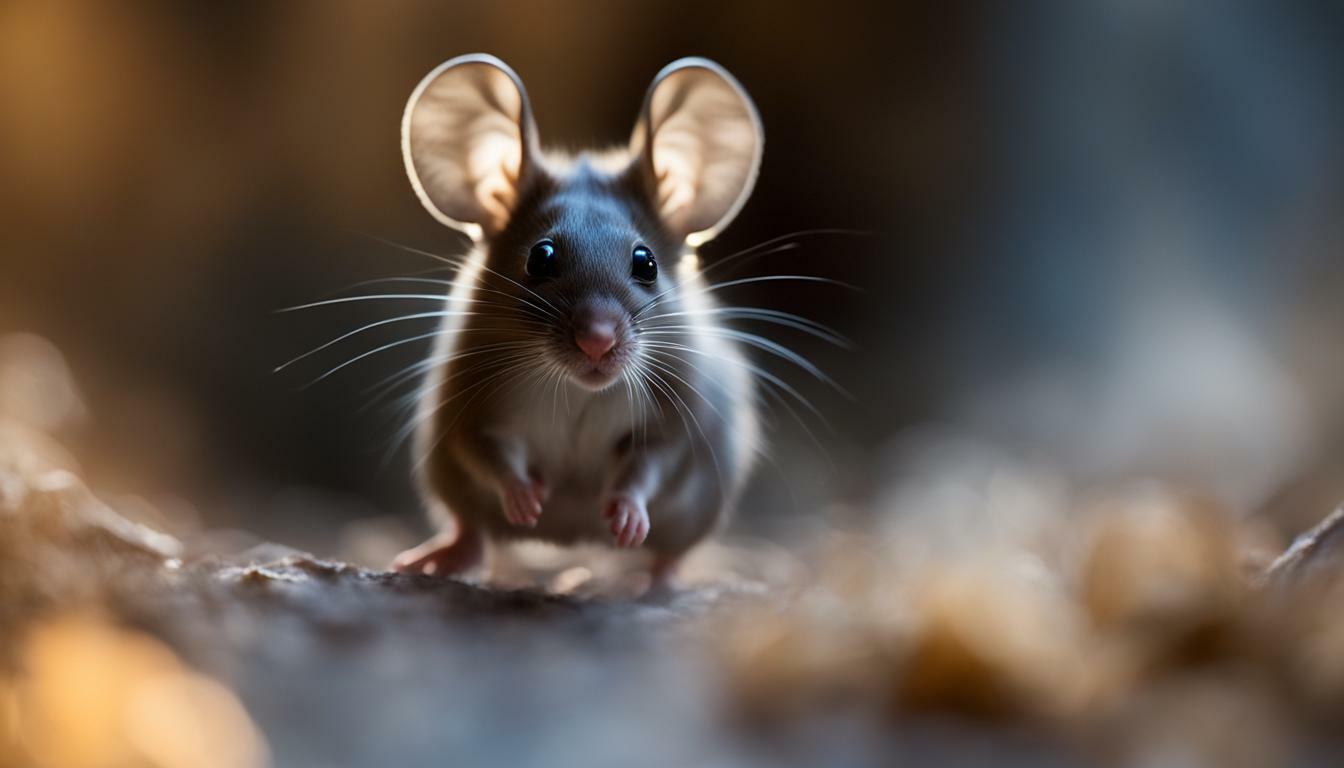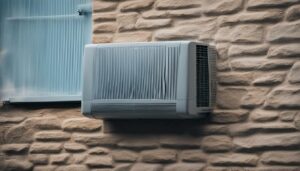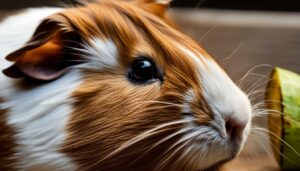Have you ever wondered if mice have eyelids? Let’s uncover the truth about these tiny creatures’ eye structures.
Mice do have eyelids. When mice close their eyes, their upper and lower eyelids come together to seal off the eyeball. They are born with their eyes closed and don’t open their eyelids until about 10 to 12 days after birth. Mice also have a third eyelid called the nictitating membrane, which is a thin film that protects the eye and helps clean the surface.
Eyelids function normally most of the time, but if there are issues such as redness, discharge, or pain in the eye area, it may indicate a problem that requires veterinary attention. Eyelid closure during embryogenesis is vital for the development of ocular adnexa, including eyelid and extraocular muscles. Failure of embryonic eyelid closure can contribute to congenital eye anomalies in both mice and humans.
Key Takeaways:
- Mice have eyelids that seal off the eyeball when closed.
- They are born with their eyes closed and open their eyelids after about 10 to 12 days.
- Mice also have a third eyelid called the nictitating membrane.
- Eyelids may experience issues such as redness, discharge, or pain, which could require veterinary attention.
- Eyelid closure during embryogenesis is crucial for the development of ocular adnexa.
- Failure of embryonic eyelid closure can lead to congenital eye anomalies in mice and humans.
Mouse Eyelids: Anatomy and Function
Mouse eyelids play a crucial role in protecting their delicate eyes. Let’s explore their anatomy and how they function.
When mice close their eyes, their upper and lower eyelids come together to seal off the eyeball, providing a protective barrier against external elements. This closure helps prevent dust, debris, and other potential irritants from entering the eye, keeping it clean and healthy. Mice are born with their eyes closed, and it typically takes around 10 to 12 days for their eyelids to open after birth.
In addition to the upper and lower eyelids, mice also have a unique feature called the nictitating membrane, which is a thin, translucent film located in the inner corner of the eye. The nictitating membrane, also known as the third eyelid, acts as an additional protective layer. It helps moisten the eye surface, clear away any foreign particles, and provide extra defense against potential harm.
The eyelids of mice function normally most of the time, ensuring the eyes are safeguarded. However, if you notice any signs of redness, discharge, or pain in the eye area, it may indicate an issue that requires veterinary attention. These could be symptoms of underlying eye problems that need to be addressed promptly for the well-being of your pet.
In summary, mouse eyelids, including the nictitating membrane, are essential for protecting their eyes from external elements. Their proper function is crucial for maintaining eye health in mice. Although eyelids usually work seamlessly, any abnormalities or discomfort in the eye area should be evaluated by a veterinarian to ensure your furry friend’s eye health and overall well-being.
| Key Points: |
|---|
| – Mouse eyelids come together to seal off the eyeball when closed |
| – The nictitating membrane acts as an additional protective layer |
| – Proper function of eyelids is essential for eye health in mice |
| – Abnormalities or discomfort in the eye area may indicate the need for veterinary attention |
The Development of Mouse Eyelids
The development of mouse eyelids occurs in fascinating ways. Let’s learn about the timeline of their eyelid opening and the significance of embryonic eyelid closure.
Mice are born with their eyes closed, and it takes about 10 to 12 days for their eyelids to open. During this time, the eyelids are fused together, providing a protective barrier for the developing eyeballs. The process of eyelid opening is known as eyelid dehiscence. Once the eyelids open, mice gain the ability to see and navigate their surroundings more effectively.
Embryonic eyelid closure is a crucial stage in the development of mouse eyelids. It occurs during embryogenesis, which is the process of prenatal development. The closure of eyelids during this early stage plays a vital role in the formation of ocular adnexa, which includes the eyelid and extraocular muscles. Proper closure ensures the structural integrity and functionality of the eyelids, enabling them to protect the eyes from external elements and potential harm.
In summary, mice do have eyelids, and their development is a complex and intricate process. From their closed eyelids at birth to the later opening and functioning of the eyelids, mice rely on this crucial part of their anatomy for protection and visual acuity. Understanding the timeline of eyelid opening and the importance of embryonic eyelid closure helps shed light on the fascinating world of mouse eyelid development.
| Key Points: |
|---|
| – Mice are born with closed eyelids and open them around 10 to 12 days after birth. |
| – Embryonic eyelid closure is essential for the formation of ocular adnexa, including the eyelid and extraocular muscles. |
| – Proper eyelid closure ensures the protection and functionality of the eyes. |
Eyelid Issues in Mice
While mouse eyelids typically function without problems, there are situations where issues may arise. Let’s explore common eyelid-related concerns in mice and when to seek professional help.
One issue that mice may experience is redness and swelling around the eye area. This can be a sign of an infection or irritation, which may require veterinary attention. Additionally, if you notice any discharge or crustiness around the eyelids, it could indicate an underlying issue such as conjunctivitis or a blocked tear duct.
Pain or discomfort in the eye area is another concern that should not be ignored. Mice may exhibit signs of discomfort such as rubbing or scratching their eyes excessively. This could be a sign of corneal ulcers, foreign objects in the eye, or other serious conditions that require immediate attention from a veterinarian.
It’s important to monitor your mouse’s eyelids regularly for any abnormalities or changes in appearance. If you notice any persistent issues with the eyelids or surrounding area, it’s always best to consult a professional. They can properly diagnose the problem and provide appropriate treatment to ensure your mouse’s eye health.
| Symptoms of Eyelid Issues in Mice | When to Seek Veterinary Attention |
|---|---|
| Redness and swelling around the eye | If it persists for more than a day or is accompanied by other symptoms |
| Discharge or crustiness around the eyelids | If it is thick, yellow or green in color, or is accompanied by other symptoms |
| Pain or discomfort in the eye area | If your mouse is excessively rubbing or scratching their eyes, or if there is noticeable redness or cloudiness in the eye |
Mouse Eyelids in Comparison to Rats
Are mouse eyelids different from those of rats and other rodents? Let’s compare the characteristics of eyelids in different rodent species.
When it comes to eyelid structure, mice and rats share many similarities. Both mice and rats have upper and lower eyelids that come together to protect their eyeballs. This ensures that their eyes are sealed off from the external environment when they close their eyes. The purpose of this protective mechanism is to keep dust, debris, and other potential irritants out of their eyes.
However, there are also some differences in the eyelids of mice compared to rats and other rodents. One noticeable difference is the presence of a third eyelid called the nictitating membrane in mice. This thin film provides an additional layer of protection for their eyes and helps with cleaning the surface of the eye. The nictitating membrane is translucent and can sweep across the eye to remove any particles or foreign substances that may be present.
Table: Comparison of Eyelid Characteristics in Rodents
| Species | Upper Eyelid | Lower Eyelid | Nictitating Membrane |
|---|---|---|---|
| Mouse | Present | Present | Yes |
| Rat | Present | Present | No |
| Other Rodents | Varies | Varies | Varies |
Aside from mice and rats, the characteristics of eyelids in other rodent species can vary. Some rodents may have modified or reduced eyelids, depending on their specific adaptations and environments. For example, certain burrowing rodents may have smaller eyelids to protect their eyes from dirt and debris while digging underground.
In conclusion, mice have similar eyelid structures to rats and other rodents, with the presence of upper and lower eyelids. However, mice stand out with the additional nictitating membrane that provides extra protection and assists with eye cleaning. Understanding these variations in eyelid characteristics helps us appreciate the diverse adaptations of different rodent species.
| Summary of Eyelid Characteristics |
|---|
| Mice and rats both have upper and lower eyelids that seal off their eyeballs for protection. |
| Mice have an additional third eyelid called the nictitating membrane, which aids in eye cleaning. |
| Other rodent species may have varying eyelid characteristics depending on their specific adaptations. |
Mouse Eyelids and Congenital Eye Anomalies
The development of mouse eyelids is critical for the prevention of congenital eye anomalies. Let’s explore the connection between embryonic eyelid closure and these conditions.
During embryogenesis, the eyelids of mice form as a protective barrier for their developing eyes. The process of eyelid closure is essential in the formation of ocular adnexa, including the eyelid and extraocular muscles. If there is a failure of embryonic eyelid closure, it can lead to congenital eye anomalies in both mice and humans. These anomalies can range from minor eyelid malformations to more severe conditions affecting the entire eye.
The eyelids play a crucial role in shielding the delicate structures of the eye from external factors such as dust, debris, and injury. They also help in maintaining the moisture and lubrication of the eye’s surface. Without proper eyelid closure during embryogenesis, the eye becomes more vulnerable to these external elements, increasing the risk of congenital eye anomalies.
Congenital Eye Anomalies Associated with Eyelid Closure Failure
Some examples of congenital eye anomalies resulting from the failure of embryonic eyelid closure include eyelid coloboma, which is a gap or notch in the eyelid margin, and ankyloblepharon, where the eyelids fuse together. These conditions can cause visual impairments and discomfort for affected mice and may require intervention from veterinarians for management or treatment.
| Congenital Eye Anomaly | Description |
|---|---|
| Eyelid Coloboma | A gap or notch in the eyelid margin |
| Ankyloblepharon | Fusion of the eyelids |
Understanding the connection between embryonic eyelid closure and congenital eye anomalies in mice can provide valuable insights into similar conditions that may occur in humans. By studying the mechanisms of eyelid development and the genetic factors involved, researchers can work towards preventing and treating these anomalies in both species.
Conclusion
In conclusion, mice do indeed have eyelids, which play a vital role in protecting their eyes and ensuring proper vision. When mice close their eyes, their upper and lower eyelids come together, sealing off the eyeball from external elements. This protective mechanism helps keep the eyes safe from potential harm.
It is interesting to note that mice are born with their eyes closed, and they typically don’t open their eyelids until around 10 to 12 days after birth. During this time, their eyelids are fusing together and developing the necessary structures for normal eye function.
In addition to the upper and lower eyelids, mice also possess a third eyelid called the nictitating membrane. This delicate film acts as an extra layer of protection, helping to keep the eye moist and clean. The nictitating membrane serves as a safeguard against debris and assists in sweeping away any foreign particles that may come into contact with the eye.
While mouse eyelids function normally most of the time, it is essential to be aware of any potential issues that may arise. Symptoms such as redness, discharge, or pain in the eye area should not be ignored, as they may indicate an underlying problem that requires veterinary attention. Regular check-ups and prompt care can help maintain the overall health and well-being of mice.
The development of mouse eyelids during embryogenesis is a critical process that contributes to the formation of ocular adnexa, including eyelids and extraocular muscles. Failure of embryonic eyelid closure can lead to congenital eye anomalies, not only in mice but also in humans. Understanding the importance of eyelid development can provide valuable insights into the study and treatment of such anomalies.
FAQ
Do mice have eyelids?
Yes, mice do have eyelids. When mice close their eyes, their upper and lower eyelids come together to seal off the eyeball.
What is the nictitating membrane in mice?
The nictitating membrane is a thin film that protects the eye and helps clean the surface. Mice have this third eyelid in addition to their upper and lower eyelids.
When do mice open their eyelids?
Mice are born with their eyes closed and don’t open their eyelids until about 10 to 12 days after birth.
Are there any issues that can occur with mouse eyelids?
Yes, if there are issues such as redness, discharge, or pain in the eye area, it may indicate a problem that requires veterinary attention.
How does eyelid closure during embryogenesis affect mouse eye development?
Eyelid closure during embryogenesis is vital for the development of ocular adnexa, including eyelid and extraocular muscles. Failure of embryonic eyelid closure can contribute to congenital eye anomalies in both mice and humans.




